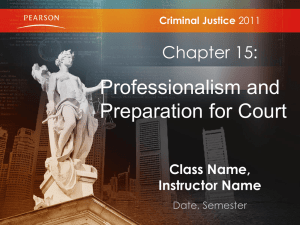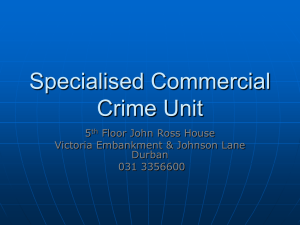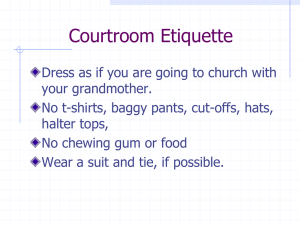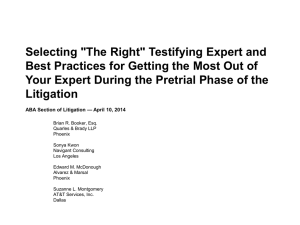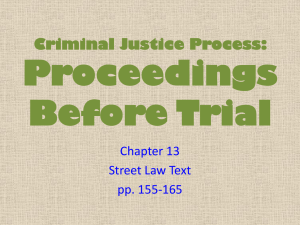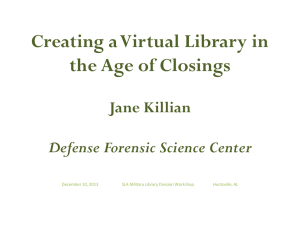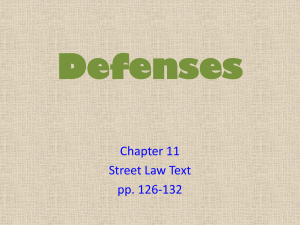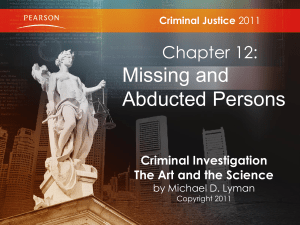Chapter18
advertisement
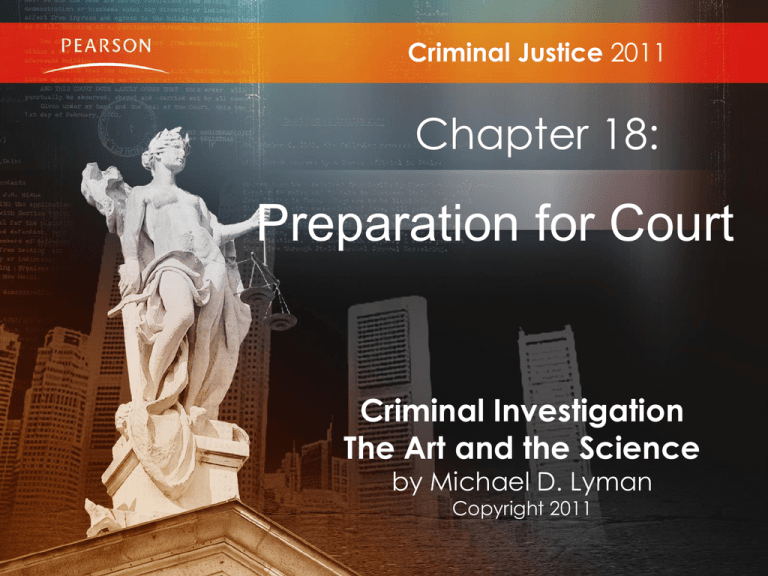
Criminal Justice 2011 Chapter 18: Preparation for Court Criminal Investigation The Art and the Science by Michael D. Lyman Copyright 2011 CHAPTER SUMMARY 18.1 Learn the role of pretrial procedures in prosecution of the defendant. 18.2 Understand how the criminal trial process operates. 18.3 Evaluate the differences between direct and crossexamination. 18.4 Learn how investigators prepare for court. 18.5 Understand the techniques most commonly used by defense attorneys to discredit an investigator’s testimony. 18.6 Learn the importance of good courtroom demeanor when testifying in court. Learning Objectives After this lecture, you should be able to complete the following Learning Outcome 18.1 Learn the role of pretrial procedures in prosecution of the defendant 18.1 Pretrial Procedures Case review by prosecutor If suspect is custody, bail hearing and arraignment takes place For felony cases, a preliminary hearing is mandated unless waived by the defendant Discovery is mandated by the judge Hearings to suppress evidence, dismiss the case, change of venue, etc… all take place prior to trial 18.1 Pretrial Procedures Plea bargaining may take place (it almost always occurs) Learning Objectives After this lecture, you should be able to complete the following Learning Outcome 18.2 Understand how the criminal trial process operates. 18.2 The Role of the Investigator in Court The investigator is the conduit for information… 18.2 The Role of the Investigator in Court Investigator Prosecutor 18.2 Court Processes Pre-trial Hearings Preliminary Hearings Trials Sentencing Hearing 18.2 The Trial in Detail Jury Selection Opening Statements Prosecution presents Defense presents 18.2 The Trial in Detail (continued) Closing Arguments Jury Instructions Jury Deliberation Court Finding Learning Objectives After this lecture, you should be able to complete the following Learning Outcome 18.3 Evaluate the differences between direct and cross-examination 18.3 Direct and Cross-examination Direct Insert a picture of the inside of an officer testifying here Prosecution asks questions Elements of the crime are covered The means, motive, and the Opportunity are also covered If known by the officer The questioning is generally Friendly and from prepared reports and notes 18.3 Direct and Cross-examination Cross Insert a picture of the inside of an officer testifying here Defense asks questions deliberately attempting to manipulate the officer The objective is to discredit the Officer using whatever means Necessary The questioning is generally Hostile Learning Objectives After this lecture, you should be able to complete the following Learning Outcome 18.4 Learn how investigators prepare for court. 18.4 Preparing for Court Review notes and reports Review all evidence, including photos and mug shot Revisit the scene if possible Meet with the prosecutor prior to testifying Add picture of a Police report 18.4 Preparing for Court Investigators may also be required to prepare witnesses and victims prior to hearings or trial. Learning Objectives After this lecture, you should be able to complete the following Learning Outcome 18.5 Understand the techniques most commonly used by defense attorneys to discredit an investigator’s testimony. 18.5 Defense Strategies Against Police Looking for inconsistencies in reports or prior testimony Purposefully mispronouncing the officer’s name repeatedly Attempting to get the office to lose his or her temper Bringing out personal biases Learning Objectives After this lecture, you should be able to complete the following Learning Outcome 18.6 Learn the importance of good courtroom demeanor when testifying in court. 18.6 Court Etiquette A few rules… Be on time and know where you are going Don’t discuss the case in public or with someone you don’t know Treat everyone with respect… you might be talking with the defense attorney or a jurror Dress appropriately Don’t discuss your personal life – it may come up in court!!! 18.6 Courtroom Etiquette Be yourself, not stiff or robotic, don’t try to be humorous Address everyone formally: Your honor, sir, m'am, the defendant, Mr. Jones, etc… Look at the person who is asking the question, then look at the fact finder (judge or jury) when answering Don’t drink water, even if it is offered, sit up straight, and don’t use slang unless you are quoting someone 18.6 Courtroom Testimony: #1 Rule Tell the Truth! 18.6 Testimony Defense attorneys learn how to capitalize on officer’s mistakes in court, here are some strategies to avoid mistakes: Confine testimony to facts Avoid expressing opinions unless asked Don’t volunteer information answer only the question Speak calmly even if unnerved Use plain, simple language – no police slang Keep your composure (never lose your temper) 18.6 Investigator Ethics Determining the truth VS Obtaining a conviction CHAPTER REVIEW 18.1 Learn the role of pretrial procedures in prosecution of the defendant. 18.2 Understand how the criminal trial process operates. 18.3 Evaluate the differences between direct and crossexamination. 18.4 Learn how investigators prepare for court. 18.5 Understand the techniques most commonly used by defense attorneys to discredit an investigator’s testimony. 18.6 Learn the importance of good courtroom demeanor when testifying in court.
